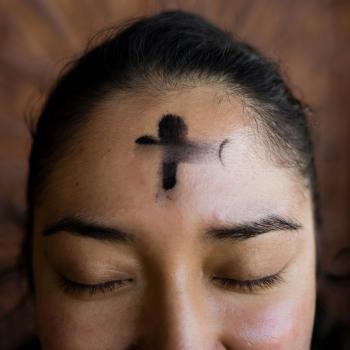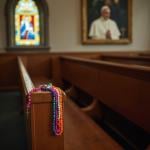 The Son who shone forth from the Father was ineffably born, two-fold in nature, of a woman. Having beheld Him, we do not deny the image of His form, but depict it piously and revere it faithfully. Thus, keeping the True Faith, the Church venerates the icon of Christ Incarnate.
The Son who shone forth from the Father was ineffably born, two-fold in nature, of a woman. Having beheld Him, we do not deny the image of His form, but depict it piously and revere it faithfully. Thus, keeping the True Faith, the Church venerates the icon of Christ Incarnate.
— Kontakion, Sunday of the Fathers of the Seventh Ecumenical Council
In the early centuries of Church history, pious Christians, without the aid of official dogmatic declarations, had to join together several apparently contradictory facts by finding the underlying truth which allowed them to be placed together. Because of this, it was easy for Christians to emphasize one fact over another in theological syntheses, causing unbalanced and erroneous answers to important doctrinal questions. Yet people would listen to such speculations, and, embarrassingly enough, fight fellow Christians who did not agree with each other’s speculations. Obviously, there were good reasons for people to defend what it was they believed to be true; theology is not a debate over mere speculations, but about truth, a truth which has practical implications to the way we should live. One great example of this is the debate over the use of holy images – while it might seem to be a question about popular piety, and therefore, a question of which form of worship Christians should use, if one explores the debate, one quickly notes that the real question was one about God and God’s relationship with creation. When the fathers of II Nicea (787) proclaimed the use of images, implicit in this is a rejection of all forms of Gnosticism which believed God did not have any real ties to the world of creation. To truly understand the conflict over images, one must understand two different facts Christians knew they had to affirm.
The first was the transcendence of God. Whatever we predicate to God, in one sense at least, cannot be truly said about God, because such affirmations describe God in a way which is less than what God truly is. Indeed, the early fathers understood that even terms like “existence” and “being” could not be truly predicated to God, because God is the source of “existence” and “being.” “Someone beholding God and understanding what he saw has not actually seen God himself but rather something of his which has being and which is knowable. For he himself solidly transcends mind and being. He is completely unknown and non-existent. He exists beyond being and he is known beyond the mind.”[1] For many early Christians, this meant that God could not be, and should not be, imagined. God transcends human conventions, and we should experience God as God truly is; images keep us within the realm of such conventions, and therefore, they become a barrier which prevents us from the pure experience of God. Evagrius, an influential and yet controversial monk, took this line of thought to its limits: “The mind could not see the place of God unless it had become loftier than all [concepts] from things. But it would not become loftier, unless it had put off the passions that bind it to perceptible things through concepts. It will put aside the passions through the virtues; it will put aside the bare thoughts through contemplation; it will even put aside contemplation itself, when there appears to it that light at the time of prayer which sets in relief the place of God.”[2]
The second fact all Christians had to accept was that of the incarnation. God became man to heal the human condition. “The Word of God the Father, therefore, appeared to us in our likeness, bringing help to our human condition in myriad ways, and brilliantly showing us the path which leads to every admirable thing.”[3] Somehow, God revealed himself personally in human form. The great disputes of the early Christian era were over this question: how did God do it, and what can we say about the God-man? They understood that, as a consequence of the incarnation, the world does not have to be rejected for us to experience God. He put himself into the world and so can be experienced in the world itself. The world is affirmed by God, so who are we to deny it?
These two facts, both affirmed by Christian theology, provide for apparently contradictory trajectories: the first appears to lead us away from the things of the world, away from the world, in order to experience God, the second tells us to experience God in the world itself. The first by itself ultimately leads to Gnosticism, while the second to pantheistic materialism. The first tells us all that we can say or think about God is going to be fundamentally wrong. The world and its ways cannot contain God, so don’t even try. The second tells us that God reveals himself in creation, that somehow God can be known in and through created means, and what is experienced is truly God, and fully God, and not just some mediated representation of God. The second is needed for any theological discussion to be valid, while the first is needed for us not to turn God into something he is not, into an idol of the human imagination. But how can the two ever be unified? Can they be?
Both iconoclasts and iconophiles understood the issues at stake. While one can suggest that the ultimate implication of iconoclasm is Gnosticism, and one would not be wrong in that assumption, classical iconoclasm was more sophisticated than traditional Gnostics. They agreed with orthodox Christianity in the basic doctrines of the faith, and with that, the fact that the world must be affirmed because God has affirmed it; they even held to a high sacramental theology, allowing them to proclaim salvation to the world in and through the things of the world itself. There was a great deal of fundamental theological agreement between the iconoclasts and the iconophiles, because both traditions worked with the same basic facts.[4] Iconoclasts would even agree that Evagrius’s extreme position should be rejected, because we are made in the image and likeness of God, so, like Theophilus of Alexandria, they could criticize any Origenistic trend that denied this fact. But the question which remained was one of emphasis, on which facts were to prevail in theological enterprises, to be used as a hermeneutic framework from which other facts were to be interpreted.
For the iconoclasts, it was the fact of God’s transcendence, when combined with Mosaic condemnation of images, which led to their rejection of the use of humanly created images in Christian worship. Clearly the Decalogue had forbidden the use of images. “You shall not make for yourself a graven image, or any likeness of anything that is in heaven above, or that is in the earth beneath, or that is in the water under the earth; you shall not bow down to them or serve them; for I the LORD your God am a jealous God, visiting the iniquity of the fathers upon the children to the third and the fourth generation of those who hate me, but showing steadfast love to thousands of those who love me and keep my commandments” (Ex. 20:4-6). Theologically, they said this was a necessary prohibition because it prevented the human mind from creating fanciful and false ideas about God. When you see God portrayed in a picture, it brings God down, not just to the level of images, but to human fancy. They would have seen the fundamental thesis of Feuerbach being correct; God would be made in the image of humanity, not humanity in the image of God.
The iconophiles readily agreed with the main points of the iconoclasts, but they didn’t think it lead exactly to the same conclusions as the iconoclasts would have us believe. The iconophiles accepted the point that humans can’t go creating images to represent God. However, the iconophiles suggested that we aren’t the ones creating the images; rather, we are re-presenting images established by, and sanctified by, God. For in the incarnation, God has provided for himself an image. “In former times God, who is without form or body, could never be depicted. But now when God is seen in the flesh conversing with men, I make an image of the God whom I see.”[5] All humans present themselves to one another in bodily form; because that body is able to be seen, it contains its own image. We would be wrong to deny God the ability to create an image to represent himself, because it would deny God’s ability to incarnate. And that is exactly what God has done. We must accept that the image established in the person of Jesus Christ perfectly represents God, so that the image of God in Jesus Christ perfectly reveals God. “He who has seen me has seen the Father” (John 14:9). And so when God, even after telling Israel not to make any graven images, had them make use of images in items of religious worship, like the cherubim put on the mercy seat of the Ark of the Covenant (cf. Ex. 25:10 -22), God showed that the rejection of images was not to be seen as absolute, but relative and contextualized.
Gnostic, and even agnostic, skepticism would prevail if theology over-emphasized the transcendence of God and it denied God’s ability to overcome that transcendence and reveal something of himself to us. Theology is capable of describing God because it describes God using that which God has determined will best point to himself. This affirmation is needed as St Dionysius, the apophatic theologian par excellence, knew; apophatic theology cannot be used to deny what God himself does, but rather, it must be used to deny the finality of human understanding as it constructs systematic ideas about the divinity. “This is why we must not dare to resort to words or conceptions concerning that hidden divinity which transcends being, apart from what the sacred scriptures have divinely revealed. […] For, if we may trust the superlative wisdom and truth of scripture, the things of God are revealed to each mind in proportion to its capacities; and the divine goodness is such that, out of concern for our salvation, it deals out the immeasurable and infinite in limited measures.”[6] The iconoclasts understood this, but they do comprehend the methods God had used to reveal himself to humanity. The chief problem of iconoclasm is that they presumed to halt God’s revelation of himself at a specific level of theological inquiry; God was not allowed to truly become immanent in creation, thus pointing out the Gnostic character of their position (even if, in part, they rejected Gnosticism). The implications of a pure rejection of images are clear, even if caution must be used in their use. Indeed, their affirmation by the council fathers at II Nicea included such caution when they defined the kind of veneration given to images (dulia, and not latria).[7]
If the truth is to be beautiful, which is what we should expect, it needs some form in which we can approach it and see that beauty. The eschaton, God, has become immanent, showing once and for all the beauty which is God. The two errors of Gnosticism and materialism have been overcome through the wise guidance of the fathers of the Church without ever denying those elements of truth found in either position. Both Gnosticism and materialism are extremes which must be overcome and avoided, and yet both are tendencies in which humanity keeps falling for, time and time again. The spirit, clothed in sin, thinks it is merely the material world which leads to sin, and so wants out of the body to overcome such sin; of course, as the fallen angels show, sin exists in the spiritual realm as well. The materialist denies the spirit, and sees value only in the empirical world. The spiritualist is right to point out the transcendent aspect of human existence, while the materialist is right to point out that human existence can only be human when it is connected to, but not limited to, the empirical world. Only by the light of truth, proclaimed by the holy fathers of the Church, can we see are way between the twin terrors; it is only when the two tendencies are joined together and become one that we can experience life in its fullness. Thankfully, God made sure that the Church was guided by wise leaders, so as not to neglect this necessary component of the truth; it is for this reason we should rejoice and sing:
Most glorious are You, O Christ our God! You have established the Holy Fathers as lights on the earth! Through them you have guided us to the true faith! O greatly Compassionate One, glory to You!
— Troparion, Sunday of the Fathers of the Seventh Ecumenical Council
Footnotes
[1] Pseudo-Dionysius, “Letter 1” in Pseudo-Dionysius: The Complete Works. trans. Colm Luibheid (Mahwah, NJ: Paulist Press, 1987):263.
[2] Evagrius Ponticus, “”On Thoughts”, pgs. 89 – 116 in Evagrius Ponticus. trans. A.M. Casiday (London: Routledge, 2006):114-5. Even after he was condemned for heresy, Evagrius remained one of the most influential thinkers of the early church, and his thought, while adapted, helped shape many important theological minds.
[3] St Cyril of Alexandria, On the Unity of Christ. trans. John McGuckin (Crestwood, NY: St Vladimir’s Seminary Press, 1995), 102.
[4] See Jaroslav Pelikan, The Spirit of Eastern Christendom (600 – 1700) (Chicago: The University of Chicago Press, 1977), 93 – 104.
[5] St John of Damascus, On the Divine Images. Trans. David Anderson (Crestwood, NY: St Vladimir’s Seminary Press, 1994), 23 (I.16).
[6] Pseudo-Dionysius, “The Divine Names” pgs. 49 – 131 in Pseudo-Dionysius: The Complete Works. trans. Colm Luibheid (Mahwah, NJ: Paulist Press, 1987):49 (I.1). Of course, there is a debate as to what this revelation and what this scriptures should be seen as; the greatest, and central, revelation is the Biblical Canon, but as many doctors made known, there is a way in which the world itself is a kind of scripture to be used to lead us to God; God reveals himself to us in many ways, and we can and should use all such revelations, though keeping the Biblical Canon as the central authority.
[7] Cf. NPNF:2(14):550.
















